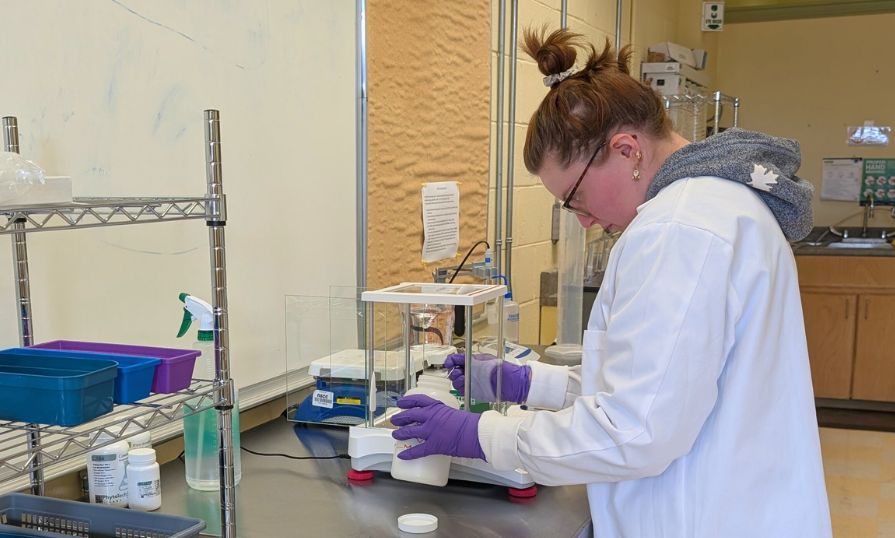TJ’s journey through horticulture and research

If you’ve ever met TJ, you’ll know she’s full of surprises. With bendy joints, unusually long fingers (perfect for dominating Guitar Hero) and a deep love for compost and worms, TJ brings an unexpected mix of quirky charm and scientific curiosity to everything she does. Whether she’s tending to her indoor garden, what she affectionately calls her “plant cemetery,” or shaping a 7-foot rhododendron in the blazing sun, her enthusiasm for horticulture is unmistakable.
A green thumb from the start
TJ’s journey into horticulture began long before she stepped foot on an NSCC campus. As a kid, she was the unofficial caretaker of her mother’s indoor plants and even bred pelargoniums and geraniums in high school. That early fascination with plants laid the groundwork for her current studies in horticulture at NSCC, where she’s developed a passion for research, integrated pest management and the art of plant identification. “I have a knack for memorizing botanical Latin,” she says, a skill that’s proven especially useful in her coursework and lab work.
Although TJ entered the Horticulture and Landscape Technology program with a strong foundation, her time at NSCC has helped sharpen and expand her skills, particularly in landscaping and pest management. One area she’s still working on is visualizing measurements accurately in real-time. “Three inches or 1 foot all seem to blend unless I'm actively measuring,” she admits. Still, she’s embracing the challenge head-on, “I have plans to build a patio and replace a ramp with a deck. I want it to look good, so I’m working on these skills to make sure it adds value to my home, not makes it look like a haunted house.”
Enter the EATLab
TJ’s hands-on experience took a leap forward when she joined the Applied Environment and Agriculture Technology Research Lab (EATLab). After relocating to Kings County, a conversation with an instructor led her to a part-time opportunity in the lab. “We had just visited a tissue culture lab at Acadia University, and I thought, ‘Hey, it’s worth a try.’” That leap of faith turned into nearly a year of hands-on research alongside Research Scientist Mat Vankoughnett and Research Associate Adèle Bunbury-Blanchette.
During the summer, TJ was part of a team working on a Christmas tree project aimed at improving needle retention, a key trait for expanding markets and boosting profits for Nova Scotia growers. Her role includes everything from cracking open pinecones to extract genetic material, to plating embryos and preparing nutrient media for baby trees.
Her work is part of a larger effort to future-proof Nova Scotia’s Christmas tree industry. As project lead Adèle explains, “Each tree we help improve has the potential to support wildlife, absorb carbon and reduce waste by offering a sustainable alternative to artificial trees.”
Learning that makes a difference
TJ sees a clear connection between what she learns in the classroom and what she applies in the lab. “In class, we learn about 5S+S for safety and cleanliness. In the lab, it’s essential, we work in sterile conditions to prevent contamination and protect the integrity of our samples.”
That hands-on experience has also shown her how research can make a real impact. “I find it an honour and a privilege,” she said. One of her proudest moments was writing an article for the Christmas Tree Council of Nova Scotia newsletter on behalf of the EATLab team. “I printed a copy and framed it for my mother.”
TJ’s commitment to community goes beyond the lab. Whether it’s supporting local firefighters, buying local produce or attending community events, she sees research as a practical way to support environmental sustainability and strengthen her community.
Building bridges between education and industry
TJ believes partnerships between education, research and industry are essential. “They give students real-life experience and help build strong portfolios,” she explained. “It allows students the ability to experience a new position in STEM while still maintaining an educational basis.”
This experience has sparked new ambitions, possibly transferring credits into a bachelor’s or master’s program in the future. “I’ve always been a sponge when it comes to knowledge,” TJ said. “I’d love to be published in a peer-reviewed paper someday or even just be a little old lady running her own greenhouse.”
TJ’s advice for students considering applied research? “Don’t be discouraged! It’s okay for plants to die or for plates to get contaminated, it’s part of the process.” She’s learned to embrace the unpredictability of research and recommends staying curious, read widely, keep up with safety protocols and explore new techniques that could benefit your team.
